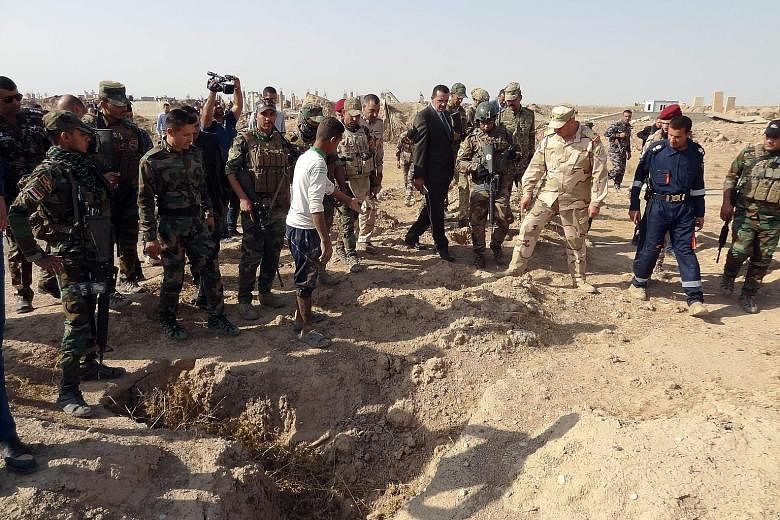HAWIJA, Iraq • A shepherd heard the gunshots and the screaming.
As Islamic State in Iraq and Syria (ISIS) fighters executed at least 60 people at a remote military base in northern Iraq one day last year, he cowered in his home nearby, terrified.
When it was safe to go out, he found piles of bodies; many of them he recognised as his neighbours. He buried them himself.
"They were slaughtering people for all kinds of reasons - those caught using the Internet, those suspected of being witches," the shepherd, Mr Saad al-Omar, said at the site of a mass grave in Hawija last Tuesday.
"Here, I saw those victims, my neighbours. I saw bodies of mothers with their children. They had been shot. They had been burned. They were all dead."
That executions routinely took place in his home town, Hawija, was well known, proudly publicised by ISIS during its 2 1/2 -year rule in the town.
But Mr Omar's grisly knowledge represents something rare in the quest for justice - a witness who can lead the authorities to the bodies and identify many of them.
As Iraqi officials declared last Friday that they had taken the last Iraqi town held by ISIS, reducing the group's self-declared caliphate to a tiny remnant on the Syrian side of the border, they were still trying to comprehend the scale of the group's horrors.
So far, they have found the sites of more than 70 mass graves, numbers that have overwhelmed the nation's police and forensics resources, as well as the Iraqis' international partners helping to search for tens of thousands of missing people.
In September, the United Nations Security Council empowered a special adviser to help Iraq investigate potential war crimes, including mass killings, committed by ISIS members. The adviser's team will not arrive in Iraq until early next year.
Given the limited resources and the cost of forensics, it is unclear how many mass graves will be properly exhumed, let alone how many - if any - suspects will face justice.
In Hawija, a small town in a flat, arid valley in south-western Kirkuk province, the head of civil defence, Colonel Brahim Attiyah al-Jabbouri, said he has fielded numerous, frantic requests each day from families searching for loved ones.
For him, the quest for answers is deeply personal. Two of his cousins were detained by local ISIS operatives and never seen again.
One, a 45-year-old father of six, Mr Nawaf al-Abdullah, had worked as an interpreter for United States troops at the American military base in Hawija.
ISIS used the abandoned base, Forward Operating Base McHenry, as its execution site.
More than a month after its liberation by Iraqi forces, Hawija remains a ghost town. Whole neighbourhoods have been reduced to rubble, the commercial district torn apart by artillery fire. Most residents are waiting for local services to be restored before they return from their humanitarian aid camps.
The mass grave there remains untouched, the countless sun-bleached bones scattered along the sand awaiting collection and identification.
Col Jabbouri said that although he was desperate for answers about what happened, he did not have the equipment or personnel needed for a thorough exhumation.
"I have dozens of people calling and writing to me on Facebook," he said, standing at the grave site.
"Everyone wants answers. We are frantic. But without experts, there is no way to really know who is here."
NYTIMES


